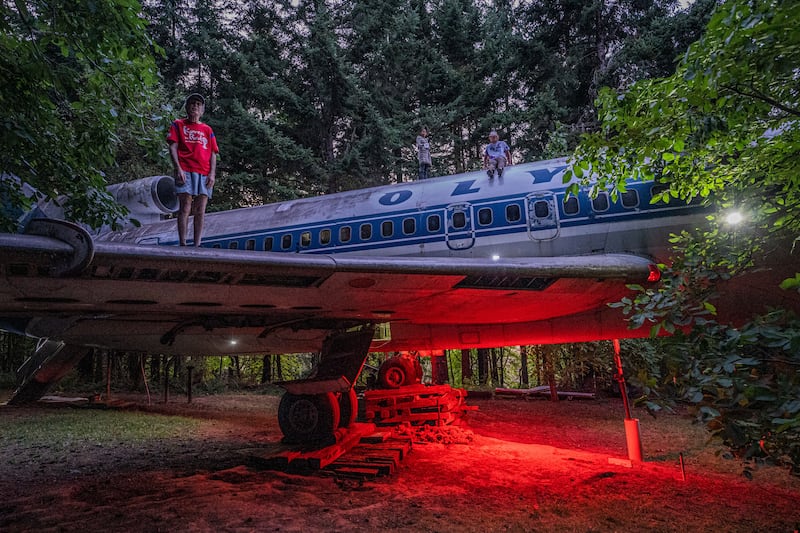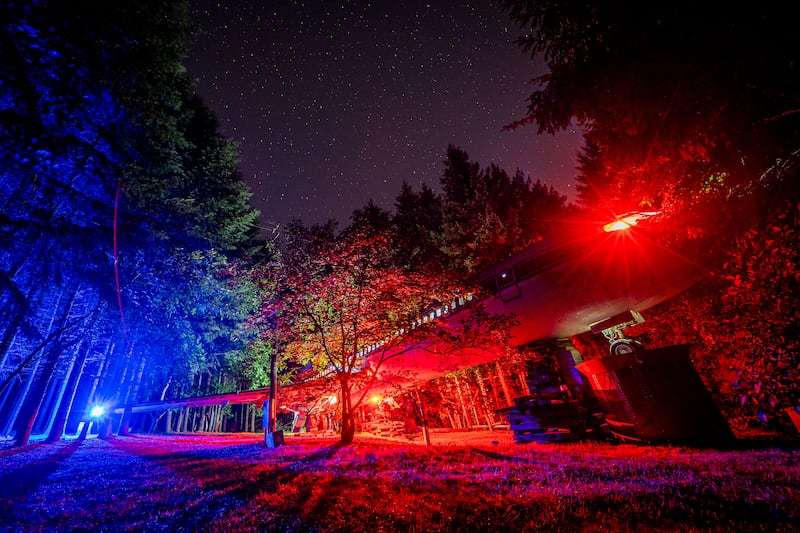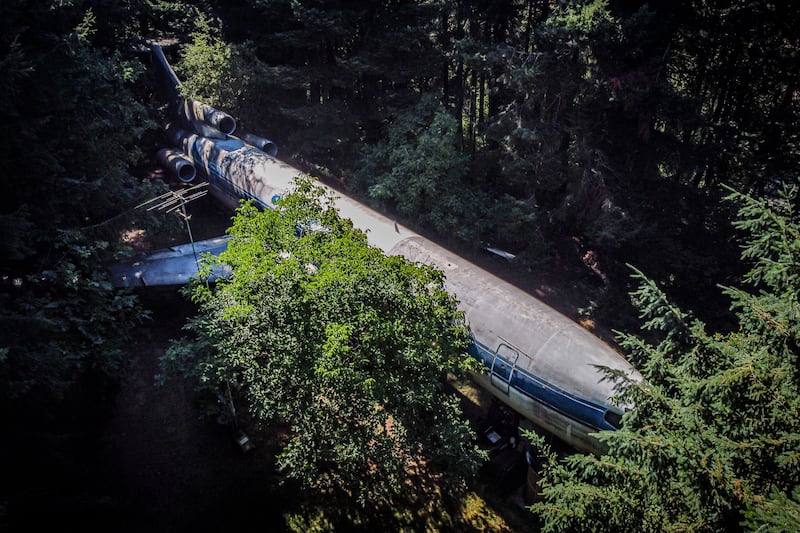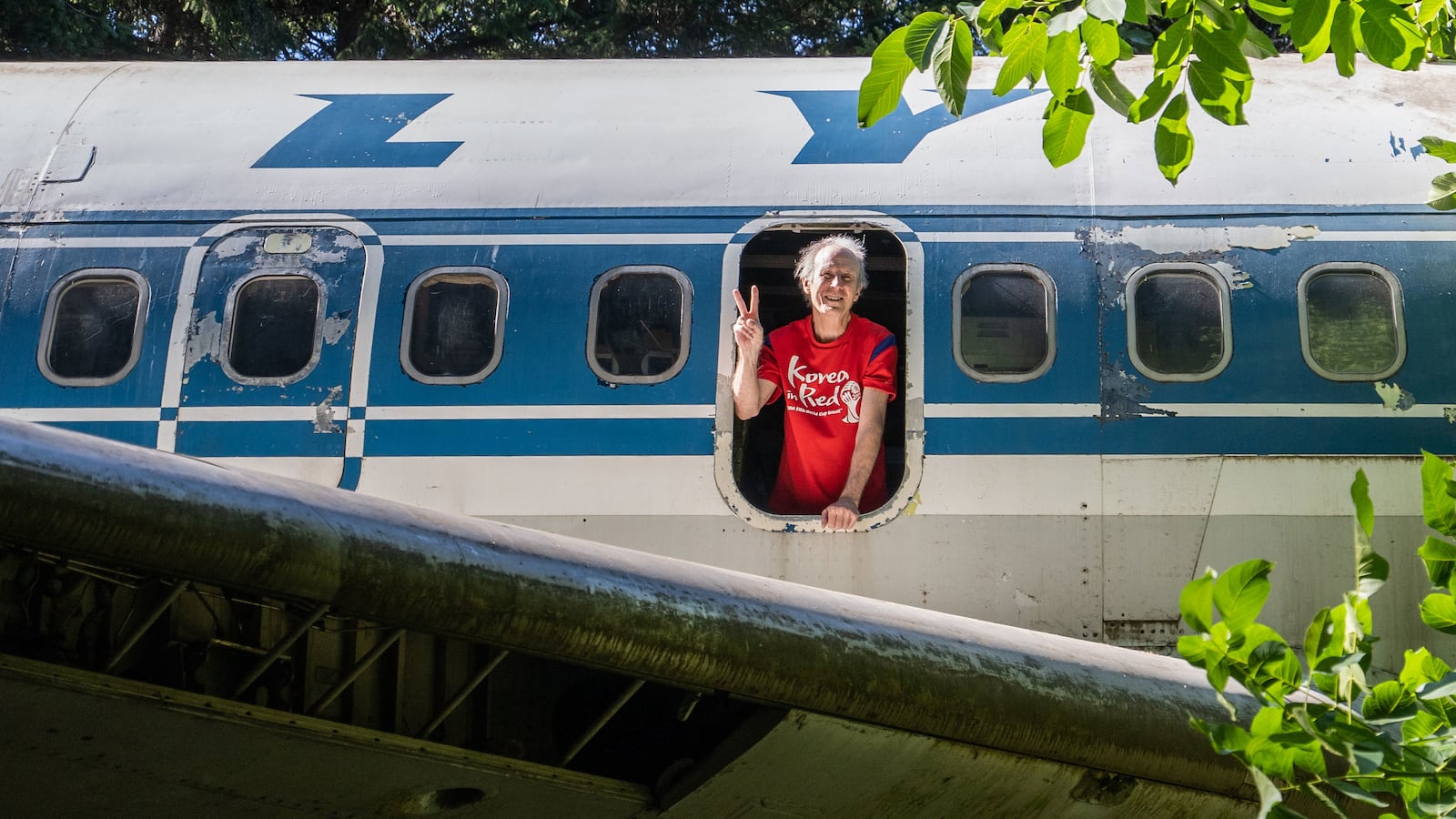Bruce Campbell sleeps naked on the couch of a decommissioned 727-284 plane in Hillsboro, Oregon. It’s a fact that the 71-year-old retired engineer offers freely. It’s also one of many other personal facts he offers up, along with a clothed demonstration of how he bathes in his homemade shower, which features a hose and a flexible chest-high piece of circular plastic that he can’t bear to upgrade because it’s become a conversation piece. Yes, this is a lot of personal information to glean from someone you just met. But Campbell’s openness is understandable—it’s hard to have any secrets when you’re known as the local Airplane Home guy.
There’s nothing new about rethinking traditional housing. In Wales, Tolkien mega-fan Simon Dale built a Hobbit house for a scant £3000—a hillside structure which also doubles as one of the eco-friendliest buildings in the world. Beijing-based architect Dai Haifei built and briefly lived in an egg-shaped house outside his office to draw attention to rising housing prices. And of course, for anyone looking to get into the alternative home game, a literal cottage industry has sprung up around tiny houses, which are often parked on trailers to skirt local zoning laws.
But what stands out is Campbell’s absolute devotion to his materials. Located up a hill so steep that our Uber driver prematurely ends the trip, his intact plane looks like it just fell from the sky and into the forest on his 10-acre property. It’s a surreal vision that’s only heightened when he peeks out his head out of a hatch and offers us a full-throated hello. Jokes about Lost and Airplane!? He doesn’t own a television, but has heard them all, and still graciously chuckles every time.
It is an act of love to preserve an entire airplane—to say nothing of living out of it. While the majority of the seats have been stripped away, and utilities like a washer and refrigerator have been added, the spirit of the plane’s former life remains in the interior as well. Tiny bathrooms flush with assistance from the property well. A vintage drink cart is reimagined as a pantry, where guests are offered their pick of his abundant snack collection. (I accept his offer and, quite literally, drink the Kool-aid.) The majority of the floors are replaced with transparent Plexiglas to show off the still-intact engineering details. And the cockpit, complete with flight controls, functions as a surprisingly cozy reading nook—or for anyone with unrealized dreams of flying the friendly skies, a pilot cosplay area. Campbell warns me that it’s a forever work in progress. The airline seats pushed against the curved walls, still covered in Greece’s Olympic Airways fabric, are functional but not bolted down. So, he’s directed guests where to safely sit by using oversized rubber spiders to block out danger zones. He introduces each of them to me using their formal Japanese names.

Even in its simplicity, the Airplane Home is a tremendous accomplishment. For all our collective desires to create a private citadel, here’s someone who actually did it. But as Campbell insists, it’s an achievable dream. A natural showman, he gathers the small clutch of people who have stumbled onto his property to share his backstory, arranging us on the right wing of the airplane for an avionics story time.
Campbell’s journey began in 1999 when his engineering-oriented brain was struck with an idea—jetliners are retired at a rate of about three per day, and this earthquake, rot, and wind-proof technology is simply being shredded. (“On the very same planet, at the very same time, the very same species wanders around and gets sticks, they take the sticks someplace, and pound them together with metal spikes to make homes,” he says. “Primitive of us!”)
The way he saw it, the world needed a gorgeous example of what living in an airplane could look like. So, he acquired the same plane that carried Jacqueline Kennedy Onassis as she accompanied the body of Aristotle Onassis for burial on a private island off the coast of Greece. While the plane would ultimately prove to be a learning process—partnering with a shredding company, and attempting to install it during an El Niño in the winter of 1999 left him about $220,000 in the hole. But he insists that anyone with some land can bribe their next-door neighbor to use their property as a landing strip for a day, hire pilots to fly their plane to its final resting place, and dramatically lower costs along the way.
It’s a speech so compelling, I am briefly lost in the idea of an airplane house of my own.
The mini-crowd disperses, and Campbell bustles around the property as we continue chatting, cleaning out the foundations at the bottom of the fuselage, and inspecting hedges as he patiently answers my questions. While the time from the project’s inception to parking the airplane on his prosperity was relatively short, restoring the plane and tending to his prosperity has been an on-going process ever since.

All which he’s been careful to document in minute detail for anyone who might dream of following in his footsteps. It wasn’t until 2001 that he attached the wings, thus fulfilling his personal mandate of making sure his airplane home actually looks like an airplane. By 2005 he reinstalled cockpit panels (although he’s still looking to update the lighting system.) And it wasn’t until 2014 that a temporary front gear pillar was put into place (one he still hopes to finish, weather permitting).
Campbell is optimistic, and rightfully proud of what he’s accomplished. But he also emphasizes again that mistakes have been made during the learning process, leaving his plane less than aesthetically pleasing. (He and his sweetheart are planning a version 2.0 in Miyazaki, in hopes that it will serve as a proper model plane home.) Still, I can’t overcome the feeling that Campbell knows something I don’t. It’s not just the degree in engineering that sets us apart. He shakes his head at lighthearted implications that he’s a visionary, evil genius, or, should one make an incredible leap in logic given the location—D.B. Cooper in hiding. (His website also clarifies that he’s neither an “extraterrestrial nor android,” leaving little room for conspiracy theories.)

But what is true: by doggedly following his passions, Campbell discovered an effective way to sidestep the loneliness that often comes with people later in life. In eras not defined by a deadly virus, he throws parties—anything from a subdued “Concert on a Wing” series, to full-blown dance events that can attract over 1,000 people. But he also welcomes day-to-day visitors. Guests are encouraged to park on his property, camp among the trees, swing by to grab drone shots, or even sleep on the cockpit-adjacent blowup mattress for a night. (A low-key lodging service he offers for free.) He estimates 10-20 people take him up on his hospitality every day, and several times a month someone sleeps in the plane. Which is fine by him—while visitors are curious about his way of life, he genuinely enjoys the people and ideas that his home has brought his way.
We settle in for the night and continue to swap stories over a pizza. (The delivery person, perhaps the only area resident to not know about the Airplane Home, experiences a literal jaw drop moment when he arrives with our dinner.) Around 1 a.m. our conversation about cryptocurrency, the artificial intelligence he’s piecing together gig by gig on his crowded work tables, and a shared love of Japan winds down, and yawns begin to take over. But just as I’m about to settle down into the squeaky blowup mattress and enjoy the silence of the secluded property, a series of heavy thuds hit the roof of the fuselage, echoing through the metal tube. Campbell instantly identifies the sound, assuring me that it’s from a group of local kids who regularly use his home as a late-night jungle gym, he assures me. Good kids. While thoughts of insurance nightmares flash through my mind, he smiles at yet another round of unannounced visitors. Just more people to share in his vision.

